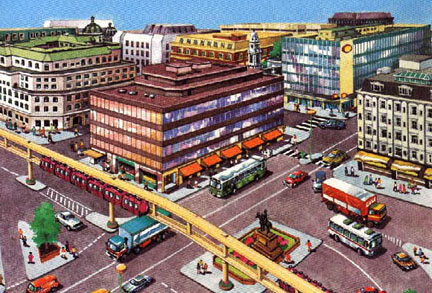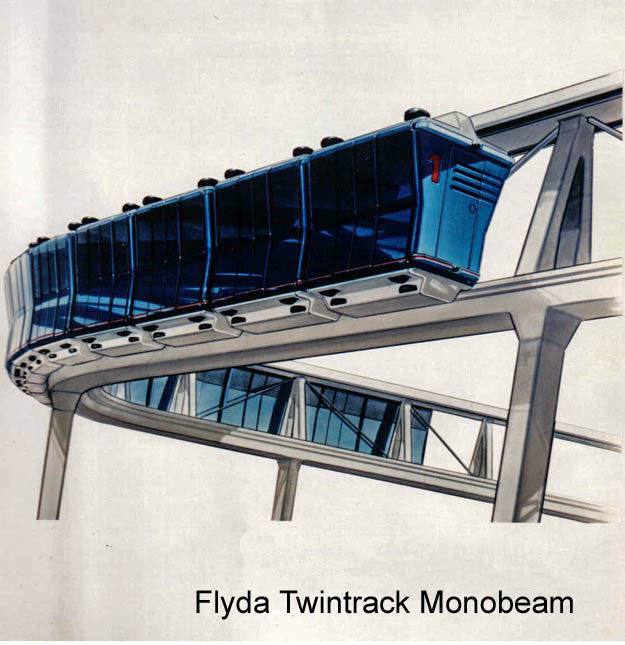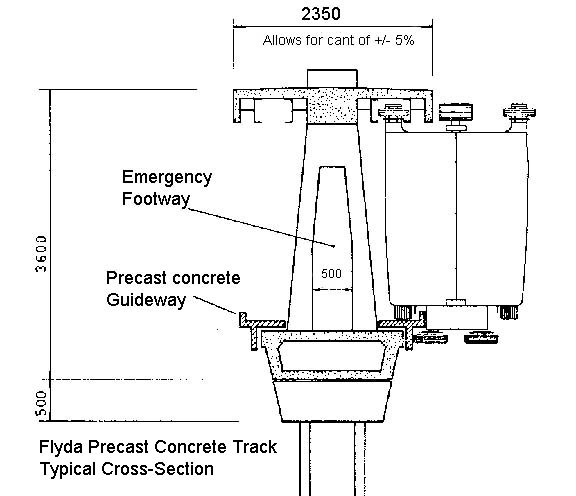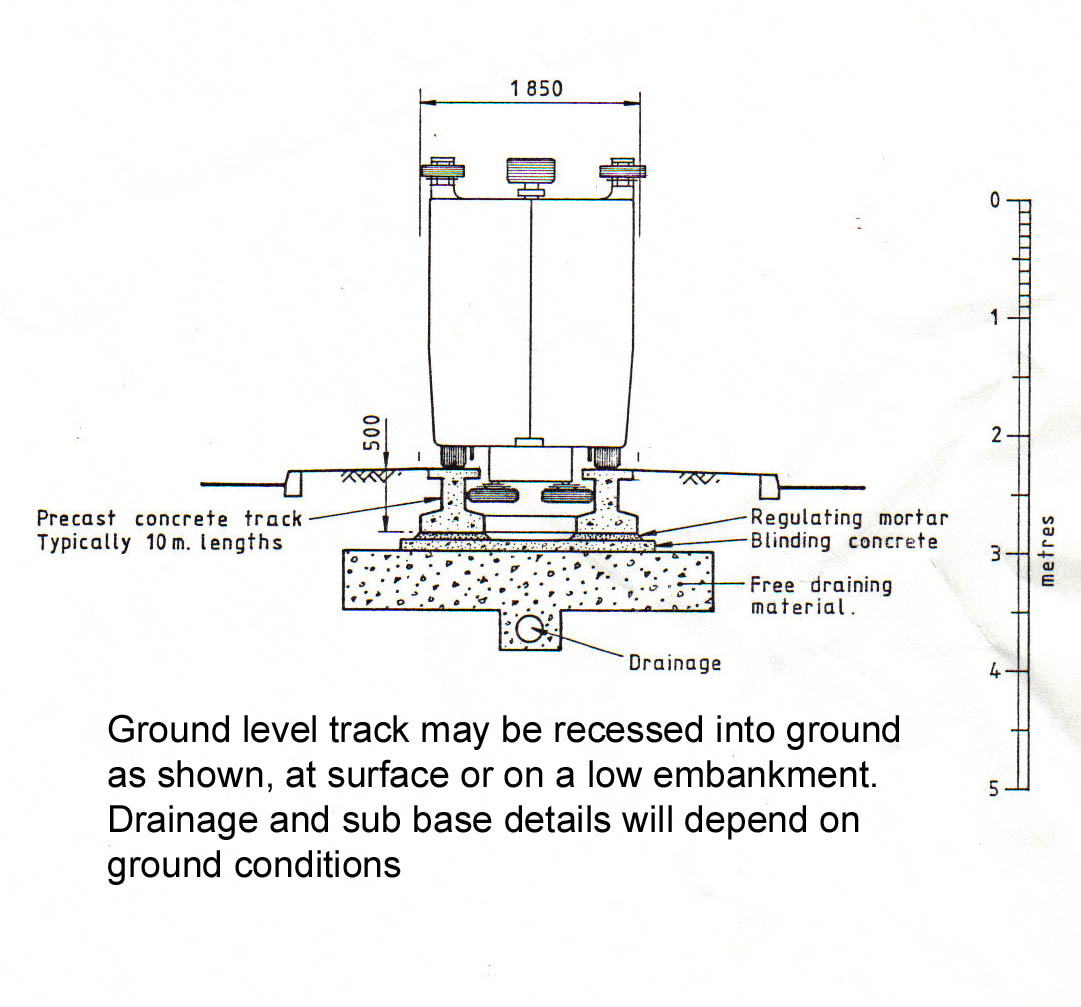Flyda Twintrack Monobeam - Transit System for both Elevated and At-Grade Operation
Update (August 4, 2007) by John Emanuel
The Flyda technology is now out of patent and in the public domain and Flyda Ltd is no longer in business. However Flyda's technology continues to be valid and potentially hugely valuable for urban transit systems. So it is included here for those people interested in better transit technology.
In urban transit systems infrastructure construction is by far the greatest cost and produces by far the greatest environmental impact. Flyda's technology can save a major part of the infrastructure costs and thus reduce the overall costs dramatically. It can also reduce the environmental impact dramatically.
Flyda overhead guideways should not be confused with monorails. Similar in scale and cost to a single direction monorail, Flyda elevated guideways carry two guideways (e.g. Northbound and Southbound), not one! Unlike monorails which may swing and can be unstable in trains, Flyda vehicles, with widely separated wheels are very stable even in long trains, and are thus capable of carrying mass transit capacity in all weathers. The trains can also run at grade when the line reaches the suburbs - a major advantage over most other elevated systems.
Flyda spent about $1m in the early 1980s on engineering design work on the tracks, vehicles and control system. In joint bids with leading UK civil, mechanical engineering contractors, Flyda offered systems for London Docklands and several small potential 'demonstrator' scale systems, mostly in the UK. Vancouver Word Fair wanted a Flyda system but their invitation was too late to implement. Edmonton, St Paul/Minneapolis, Dallas and Houston and a number of European cities were also interested at the time.
Designs in pre-stressed post-tensioned concrete and also in steel showed that the I-beam overhead guideway costs could be built at 20 - 40% of the cost of overhead structures for conventional mass transit - and with the environmental impact only of a typical footbridge. This is of great significance because, in conventional newly built urban mass transit systems, the infrastructure costs typically represent about 80% of the total cost. Potential savings in total system costs of 80% x 70% = 56% may thus be achieved from infrastructure savings alone. The relatively small size and footprint of the overhead guideway can also be used to reduce the requirement for tunneling towards the city centre.
Flyda systems used coupled trains of relatively small vehicles at high frequency (70 - 90 second headways) to reduce axle weight and thus further reduce infrastructure cost and to improve passenger service. Switching is from the vehicle. No moving parts are needed on the track.
In the 1980s a control system was under development but, with the advances in computer controls, it would now be obsolete. Control systems suitable for Flyda were commercially available and presumably could be bought in now. (2007)
Flyda vehicles have wheels beneath and on top as well. When elevated on the special ultra-light guideway, they run cantilevered - left or right - from the upper and lower wheels. They operate with the wheels underneath for operation at grade and in tunnel. (If anyone complains that Flyda vehicles have more wheels than conventional vehicles, they should take into account that wheels are cheap, reliable and negligible in cost compared with the infrastructure savings that the Flyda technology offers.)
The vehicles also had 'track selection wheels' mounted on short pivotable arms, top and bottom at the centre line of the vehicle. At a junction these pivoted wheels engage, on the top (cantilever) or bottom (at grade), to the left or to the right of a fixed 'V' shaped member on or above the track leading to a rail, left or right for a few metres. For the few metres until the vehicle has passed through the junction, the vehicle is thus guided by this track selection rail, and then the vehicle re-engages with the normal running rail.
The rails will have a short gap to allow wheels to pass through. There are no moving parts on the rails. Track selection is controlled simply by the
position of the pivoted wheels, as instructed by the vehicle control system.
Rubber tyred versions split the load carrying and the guidance between two sets of wheels, like some lines on the Paris Metro, and otherwise operate
through junctions in the same way.
Junctions sound a little complicated as the geometry is so unfamiliar. But they are simple and robust with no moving parts required on the track.
Unfortunately I no longer have a drawing of a junction but I would be happy to 'talk' through how it works with anyone interested. I do attach a simple
schematic for rubber tyred vehicles operating at grade and on cantilever on which an upper track selection wheel can be seen. (The engineer, Robert
Benaim, was responsible for a number of bridges on the Hong Kong Metro and has many other distinguished bridges to his name.)
The above cross-section diagram is for an elevated track - for a view of the entire structure, click here
Crossovers are arranged as a set of junctions analogous to a freeway crossover. One track cannot pass through another.
For high capacity, the simplest and most practical approach is to operate in long trains. You need high capacity in the centre of the city.
But as you go out to and through the suburbs you need less capacity. And at night you also need less capacity. Each Flyda vehicle was to have its own power and control system, even though in the city centre by day they would operate in long trains. As you travel out from the centre less capacity is
required, so trains can be split. For example a N bound train can split into a NW train and a NE train and thereafter stations can be half the size and
cost. Further out the trains can split again, until finally the last stations can be little more than bus stops at grade. A target of one or two
minute headways operating economically throughout the system seems completely feasible. Riders would love the frequency and budgets could be
cut drastically. You would not have the absurdity of very long, expensive empty stations at the end of the line!
It's the infrastructure that costs the money and creates the environmental and political impact...
Flyda mass transit technology uses entirely conventional components - wheels, motors, brakes etc, concrete, steel, etc; no magnetic levitation or other exotic or expensive elements. It is all based on ordinary kit - wheels, motors, etc. It would be relatively cheap for a vehicle company to design. The detailed design of the unique Flyda cantilever and track features were not a problem for Flyda Ltd. It was the design costs of detailed fitting out - doors, windows, safety interlocks...etc - which proved to be much more complex than they had anticipated. A good bus or minibus manufacturer would find much of this design task less burdensome. With the right vehicles, they could build better urban transit systems at a fraction of the competitions' costs.
With respect to the civil engineering, power supply and control, my experience 20+ years ago was that big civil and electrical contractors in
Europe, US and Canada were very quick to join the consortia I put together for various schemes. They were confident that they could readily build
anything that would be needed.Unfortunately, Flyda was not financially robust enough to survive the extended time scales inherent in mass transit projects and slowly ran out of money and was wound up. The key elements which were patented in many countries are now in the public domain, available freely.
In the opinion of the writer (JE) this technology offers a great opportunity to urban mass transit authorities, and to civil, mechanical and electrical contractors to build and use urban mass transit systems at half or less the cost of conventional systems, with far lower environmental impact and superior passenger service. The challenge is to build the first one!
I was a Director of Flyda until about a year before its demise. I still have track and vehicle designs and a wealth of knowledge and experience which would help any large consulting engineering and/or contracting company take up and develop Flyda relatively rapidly. I believe that the Flyda technology can materially improve the quality of life for urban populations around the world at costs far more acceptable than those currently available.
I have been a Director of a leading technology transfer company for some thirty years, and am now partially retired. I believe that this technology is of outstanding significance and so I would be happy to share this knowledge with any city or companies that could take this technology forward.
The following information has been derived from a Flyda brochure, published in 1983, in the U.K. . However, it has some characteristics that are similar to an American technology that is currently inactive, called System 21
Flyda systems achieve their capacity by operating trains of Flydacraft at relatively short headways. These headways are shorter than those for conventional railways, but still amply long enough to meet the safety requirements associated with the brick-wall stopping distance between trains. The controls necessary for such moderate to short headways are already commercially available and have been proved in public service passenger carrying applications.
The cantilever suspension fixes the Flydacraft securely onto the track and it therefore becomes practical to operate these small light vehicles safely in long trains, giving passenger capacities ranging from 1,000/hour up to 30,000/hour, by adjusting train length and frequencies. For 30,000/hour, trains approximately 120 metres long are required, similar to the London Underground system.
In addition, station throughput is enhanced as all Flydacraft passengers are close to the doors and can leave and enter readily. Throughput can be maximized by passengers leaving on one side and entering on the other. When heavy conventional metros experience congestion at peak periods, this often delays them at the station, reducing their effective system capacity.
Double Cantilevered Suspension
For elevated situations, Flydacraft are cantilevered from each side of an elevated Flydaway ( see cross-section diagram ). This elevated double tracked Flydaway is designed to form a narrow (1 1/2 -2 meters) light "transparent" beam approximately 3 metres high - a structurally ideal stiff low cost bridging span, which can be safely supported on relatively light low cost supports and foundations ( see guideway diagrams ). Equivalent spans on other transit systems are of massive construction 5-8 meters wide . In the later designs for the elevated track an escape/maintenance walkway down the centre was incorporated.
Flydacraft
Flydacraft can be switched by simple and elegant on-board and/or on-guideway mechanisms. Flydacraft are provided with wheels on either side so they can be cantilevered from either side or "bottom-supported" at ground level or in tunnels. The above drawing of a Flydacraft is the P12 model, designed for 6 seated and 6 standing passengers.
Below are given outline specifications of Flydacraft, as they existed in 1983:
Model P12 Model P5 Model S20 Passengers 12 5 seated 20 Length 3.1 m 2.3 m 4.0 m Width 1.5 m 1.2 m 2.0 m Cabin height 2.0 m 1.4 m 2.2 m Axle load 1600 kg 780 kg 2700 kg Wheels Pneumatic tires Pneumatic tires Steel wheels P12 prototypes were targeted for operation by 1983/84; first commercial systems by 1985/87. The Flyda company no longer exists and the technology is now in the public domain.

Flydaway and Flydacraft are trademarks of Flyda Ltd., 1983.
For more information about the Flyda technology contact John Emanuel in the U.K.
Last modified: October 04, 2010


